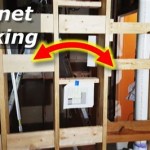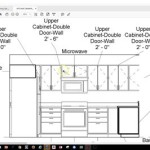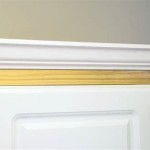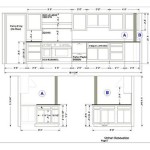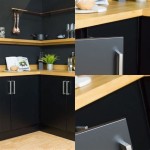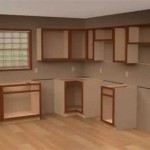Kitchen Cupboard Not Closing: Troubleshooting and Solutions
Kitchen cupboards that refuse to close properly are a common household frustration. The inconvenience ranges from aesthetically displeasing to genuinely problematic, potentially leading to damaged cupboard contents and increased wear and tear on the cabinet itself. Addressing this issue requires a systematic approach that identifies the root cause and implements the appropriate solution. Several factors can contribute to a cupboard's inability to close correctly, and understanding these factors is crucial for effective resolution.
Before embarking on any repairs, a careful inspection of the cupboard and its surrounding area is essential. This initial assessment should include a visual check for obstructions, alignment issues, and any visible signs of damage. Gathering this information will help narrow down the potential causes and guide the subsequent troubleshooting process. A methodical assessment will also prevent time and ressources loss when trying to resolve the issue.
Obstructions Preventing Closure
One of the most frequent reasons for a cupboard not closing properly is the presence of an obstruction. This can be anything from items inside the cupboard that are protruding and interfering with the door's path to objects lodged between the door and the frame. Even seemingly insignificant items can prevent a cupboard door from fully closing. It is crucial to empty the cupboard and thoroughly inspect the interior for any potential obstructions.
Overcrowding within the cupboard can also contribute to this problem. When items are packed too tightly, they can shift and press against the door, preventing it from latching correctly. Reorganizing the cupboard and removing unnecessary items can alleviate this pressure and allow the door to close properly. Consider using storage containers or dividers to maximize space and prevent items from shifting.
External obstructions are equally important to consider. Objects on the countertop that are too close to the cupboard or items leaning against the cabinet's exterior can impede the door's movement. Ensure that the area around the cupboard is clear of any potential obstacles. This includes checking appliances, utensils, and decorative items that may be interfering with the door's path.
Sticky residue or food debris can also act as an obstruction. Over time, spills and splatters can accumulate on the cupboard door or frame, creating a sticky surface that prevents the door from closing smoothly. Cleaning the door and frame with a suitable cleaning solution can remove this residue and improve the door's closure.
In some cases, the obstruction may be less obvious, such as a small piece of debris lodged in the hinge or latch mechanism. A careful examination of these components is necessary to identify and remove any hidden obstructions. Using a small brush or compressed air can help dislodge stubborn debris.
Alignment Issues and Adjustments
Misalignment is another common cause of cupboard closure problems. Over time, the hinges can loosen, the cabinet frame can warp, or the door itself can shift, leading to misalignment that prevents the door from closing properly. Identifying and correcting these alignment issues is essential for restoring the cupboard's functionality.
Loose hinges are a frequent culprit. The screws that secure the hinges to the cabinet frame or door can loosen over time due to repeated opening and closing. This looseness allows the door to sag or shift, preventing it from aligning correctly with the latch. Tightening the screws is a simple but often effective solution. If the screw holes are stripped, using longer screws or filling the holes with wood glue and toothpicks before re-inserting the screws can provide a more secure hold.
Warped cabinet frames can also cause alignment issues. Changes in humidity and temperature can cause the wood of the cabinet frame to warp or distort, leading to misalignment. In minor cases, shimming the cabinet frame can help to correct the warping. However, in more severe cases, professional repair or replacement may be necessary. Shimming involves inserting thin pieces of wood or plastic between the cabinet frame and the wall to realign the cabinet.
A warped cupboard door can present a similar challenge. Extreme heat or humidity can cause the door to warp, making it difficult to close properly. While minor warping may be correctable with clamps and moisture control, significant warping often requires door replacement. Clamping the door to a flat surface and allowing it to dry in a controlled environment can sometimes restore its original shape.
Adjusting the hinges is another method for correcting alignment issues. Many modern hinges have adjustable screws that allow for fine-tuning of the door's position. By adjusting these screws, it is possible to raise, lower, or shift the door to ensure proper alignment with the latch. Experimentation and careful observation are key to achieving the optimal adjustment. Typically, there are three adjustable screws per hinge: one for vertical adjustment, one for horizontal adjustment, and one for depth adjustment.
Hardware Malfunctions and Replacements
The hardware components of a cupboard, such as the hinges, latches, and catches, are subject to wear and tear over time. When these components malfunction, they can prevent the cupboard from closing properly. Identifying and replacing faulty hardware is often necessary to restore the cupboard's functionality.
Worn or broken hinges can significantly impact a cupboard's ability to close correctly. Hinges can become stiff, corroded, or even break, preventing the door from swinging smoothly and aligning with the latch. Replacing worn or broken hinges is a relatively straightforward task that can significantly improve the cupboard's operation. When replacing hinges, it is important to choose hinges that are the same size and type as the originals to ensure a proper fit and function.
Faulty latches or catches are another common cause of closure problems. The latch is the mechanism that secures the door in the closed position. If the latch is broken, worn, or misaligned, it will not properly engage with the catch, preventing the door from staying closed. Replacing the latch or catch is a simple repair that can often resolve the issue. Different types of latches and catches exist, including magnetic latches, roller catches, and spring-loaded latches. Choosing the correct replacement is crucial for ensuring compatibility and proper function.
Magnetic catches can lose their magnetism over time, rendering them ineffective. If a magnetic catch is no longer holding the door securely, replacing it with a new magnetic catch is a simple solution. Before replacing the catch, ensure that the strike plate on the door is properly aligned with the magnet on the cabinet frame for optimal performance.
Roller catches can become stiff or clogged with dirt and debris, preventing them from engaging smoothly. Cleaning the roller catch with a lubricant or replacing it altogether can restore its functionality. Applying a small amount of silicone lubricant to the roller can help it move more freely.
In some cases, the screws that hold the latch or catch in place may be loose or stripped. Tightening the screws or replacing them with longer ones can secure the latch or catch and improve its function. If the screw holes are stripped, using wood glue and toothpicks to fill the holes before re-inserting the screws can provide a more secure hold.
Furthermore, consider the possible corrosion or rust on metal components, especially in humid environments. Corrosion weakens the hardware and reduces its efficiency. Replacing corroded hardware is essential.
After addressing all of the above possibilities, testing the cabinet door is essential. Open and close the door several times to ensure that it closes smoothly and securely. If the problem persists, revisit the troubleshooting steps and examine the potential causes in more detail. A persistent issue might be a combination of factors instead of a single clear cause.

How To Adjust Kitchen Cabinet Doors That Won T Close

Soft Close Kitchen Cabinet Door That Does Not Softly Anymore

How To Adjust Kitchen Cabinet Doors Checkatrade

Closing The Space Above Kitchen Cabinets Remodelando La Casa

How To Adjust Soft Close Hinges 7 Steps With Pictures Wikihow

In Less Than 60 Seconds How To Adjust Cabinet Hinges On Kitchen Doors

Why Soft Close Cabinets Might Not Be Worth The Money
Trouble Upgrading Cabinet Hinges To Soft Close Door Not Flush And Can T Remove Dowels Diy Home Improvement Forum

How To Fix Soft Close Runners On Kitchen Bunnings Work Community

How To Fix Soft Close Runners On Kitchen Bunnings Work Community
Related Posts

